Our Solar SystemThe solar system is made up of the sun, planets, moons, stars, and many other things. By studying the sun and space for many, many years, we can tell that they were all made about 4.5 billion years ago ... a VERY long time ago! A large cloud of gas from the burst that started it all made a lot of dust, which was then was pressed together into things like moons. The Sun was also made this way, as well as other things that move around the Sun in space. We have just started to learn so much more about space than we ever thought was possible, thanks to things like robots and strong telescopes.
One of those other things that were made in space is moons. A moon is an object in space that circles around a planet. You can see Earth's moon most nights, but did you know that other planets have their own moons, too? One of the most well-known moons belongs to Jupiter, a large red planet that is further away from the sun. We know there are 69 moons here! The
Galilean moons are the four largest moons that move around Jupiter. Let's read to find more about each of them!
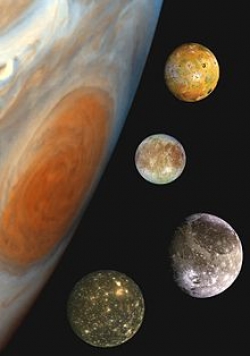
Jupiter's four Galilean moons are illustrated here. From top to bottom: Io, Europa, Ganymede, Callisto
NASA/JPL/DLR, Public domain, via Wikimedia Commons
CallistoCallisto is Jupiter's outermost Galilean moon. It is made of ice without a core or any layers. As this moon orbits, or circles around Jupiter, it always stays facing the same way. This is just like our moon! Also, like our moon, this moon looks to be different shapes depending on where it is in the sky. It is very cold there, but since it always this cold, the ice on the ground always stays there and doesn't melt. Most of this moon is made up ice, not rock. However, this ice is as hard as a rock. The surface of this moon is filled with holes, called craters.
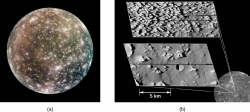
The bright spots on Callisto, Jupiter's outermost moon, are thought to be ice.
Ganymede, the Largest MoonGanymede is the largest moon in our solar system. There are a lot of craters on this moon, too, which tells us that it is pretty old. Using these holes, we can tell that half of this moon is old and the other half is pretty new, as it doesn't have as many holes, meaning it has not been around long enough for lots of things to bump into it. Even so, this moon is different from Callisto because it has a core and other different layers, just like Earth does. This moon has ice floating around it and, even though we aren't able to land on it, we are pretty sure this is some water on this moon.
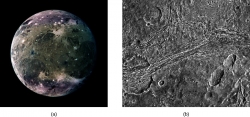
Ganymede is not only Jupiter's largest moon, but is the largest moon in the solar system.
Europa, a Moon with an OceanEuropa is a moon with an ocean and rocky land, much like Earth, that is covered with water ice. This may make it seem like Earth, but the water here is covered in a thick crust of ice. There aren't very many holes here, which tells us that the land is able to regrow and fill in the holes itself. This makes the surface look smooth in some places, but cracked in others. We can also tell from pictures that there is an ocean that has a frozen top layer, but moving water under it. When the ice breaks, we can see that water come up. This makes this moon very special since it looks like it is the only place in our solar system, besides Earth, that has a lot of water. This also tells us that it must be hot enough there to keep the water as water and not ice. These two things together tell us that if there is life on another planet, it is likely here.
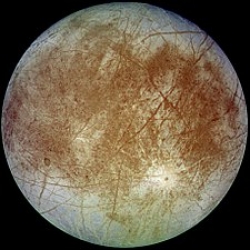
The darker regions on Europa show Europa's primarily water ice surface.
NASA/JPL/DLR, Public domain, via Wikimedia Commons
Io, a Volcanic MoonIo is the moon closest to Jupiter, and it has many volcanoes on its surface. It almost looks like a twin to our moon because they are about the same size. However, instead of being dead on the surface like our moon, there are a lot of volcanoes erupting on this moon. In fact, there are way more here than on Earth. Also like Earth, there is hot lava that comes out, but when it is ready to rise to the surface, the explosions are much bigger than anything we have on Earth.
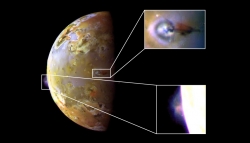
This close up shows two separate volcanic eruptions on Io.
References
Content adapted by the RocketLit Team from: